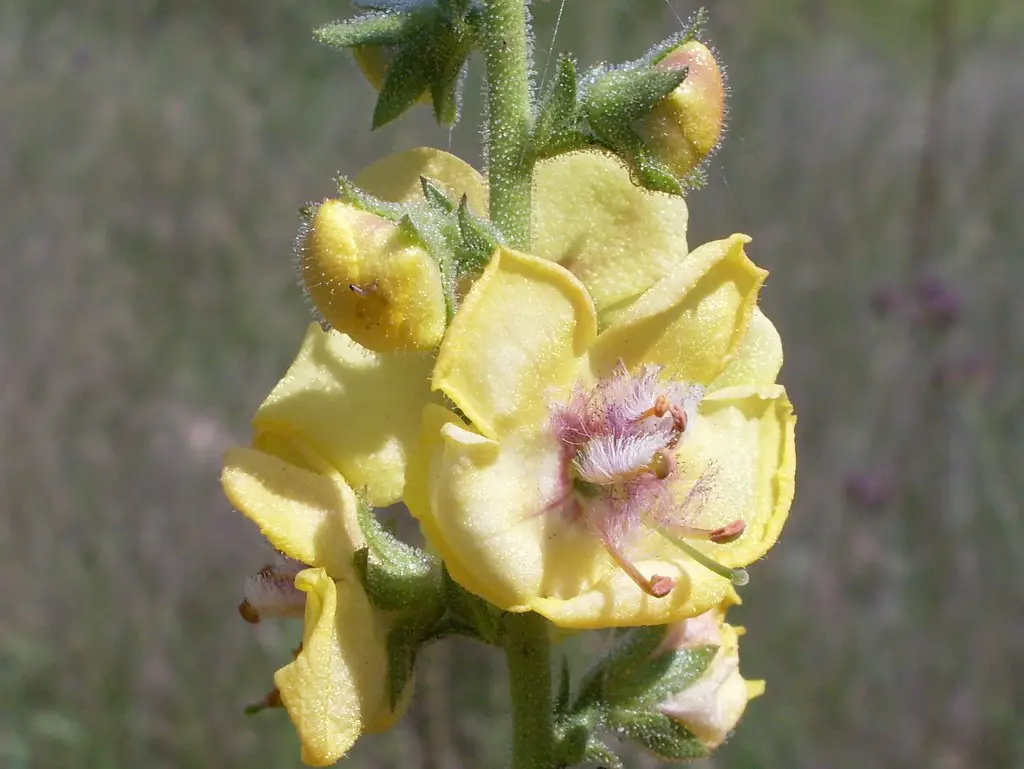Mullein, a plant known for its fuzzy leaves and towering flower spikes, is a striking addition to gardens and wild landscapes alike. Recognized for its medicinal properties, mullein has been used for centuries in traditional herbal medicine. The velvety leaves, bright yellow flowers, and impressive height add unique texture and color to any setting.
Mullein’s growth habits have earned it a place in folklore and legend. In some cultures, it’s known as the “Candlewick Plant” because the dried stalks were used as candle wicks. The tall, strong stem, covered in yellow flowers, can reach up to eight feet in height. Moreover, the plant’s medicinal properties have made it a popular remedy for respiratory issues.
Thriving in well-drained soils and full sun, mullein is often found along roadsides and in meadows. It’s a biennial plant, meaning that it completes its lifecycle over two years. The first year is typically characterized by the growth of a rosette of leaves, while the second year sees the development of the flower stalk.
| Attribute | Details |
|---|---|
| Common Names | Mullein, Velvet Plant, Candlewick Plant |
| Botanical Name | Verbascum thapsus |
| Family | Scrophulariaceae |
| Plant Type | Biennial |
| Mature Size | 5-8 feet tall |
| Sun Exposure | Full sun |
| Soil Type | Well-drained soil |
| Hardiness Zones | 3-9 |
| Native Area | Europe, North Africa, Asia |
Mullein Care
Caring for mullein is quite easy, as it is a hardy plant that requires minimal attention once established. It grows best in full sun and well-drained soil, often thriving in areas where other plants might struggle. Mullein is drought-tolerant and can be grown in poor soil, making it a great choice for xeriscaping or areas with sandy or rocky soil.
Watering should be done sparingly, as over-watering can lead to root rot. In fact, mullein often does better with neglect than with over-care. Its tall flower stalks may require staking in windy areas to prevent them from falling over.
Light Requirement for Mullein
Mullein thrives in full sun, where it produces the best flowering and growth. Planting in a sunny spot ensures the development of robust and healthy plants.
Soil Requirements for Mullein
Well-drained soil is crucial for mullein, as it does not tolerate standing water. Sandy, rocky, or even poor soil can be suitable as long as there is good drainage.
Water Requirements for Mullein
Mullein is highly drought-resistant, requiring minimal water once established. Water sparingly, especially in areas with heavy soil that retains moisture.
Temperature and Humidity
Mullein can withstand a wide range of temperatures and is hardy in zones 3-9. It prefers dry conditions and is not particular about humidity.
Fertilizer
Generally, mullein does not require fertilization. If planted in very poor soil, a light application of a balanced fertilizer in the spring may be beneficial.
Pruning Mullein
Pruning is not usually necessary for mullein. Deadheading spent flowers can encourage more blooming, and removing the flower stalk after blooming can prevent self-seeding if desired.
Propagating Mullein
Mullein can be propagated by seeds or root cuttings. Seeds can be directly sown in the garden or started indoors.
How To Grow Mullein From Seed
Sow seeds directly in the garden in the spring or start indoors 6-8 weeks before the last frost date. Lightly cover with soil, as mullein seeds require sunlight to germinate.
Common Pests & Plant Diseases
Aphids
Aphids may be controlled with insecticidal soap or neem oil.
Common Problems With Mullein
Root Rot
Avoid over-watering to prevent this issue, especially in heavy soil.
Pro Tips
- Plant in full sun for best flowering and growth.
- Use well-drained soil to prevent root rot.
- Allow the plant to self-seed if naturalization is desired.
- Avoid over-watering, as mullein is drought-tolerant.
- Consider staking the tall flower stalks in windy areas.




